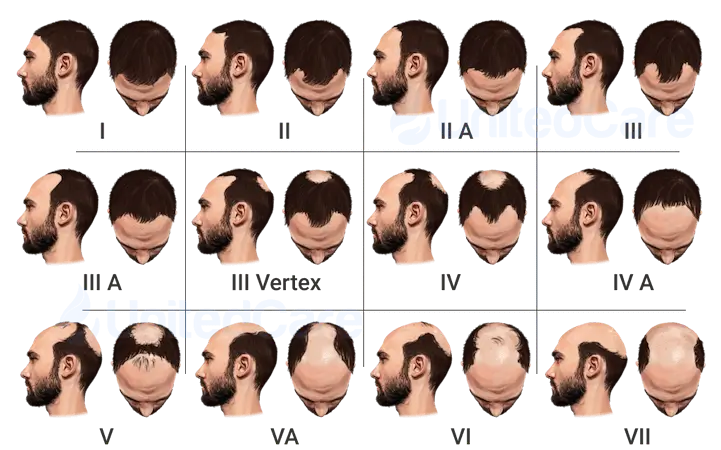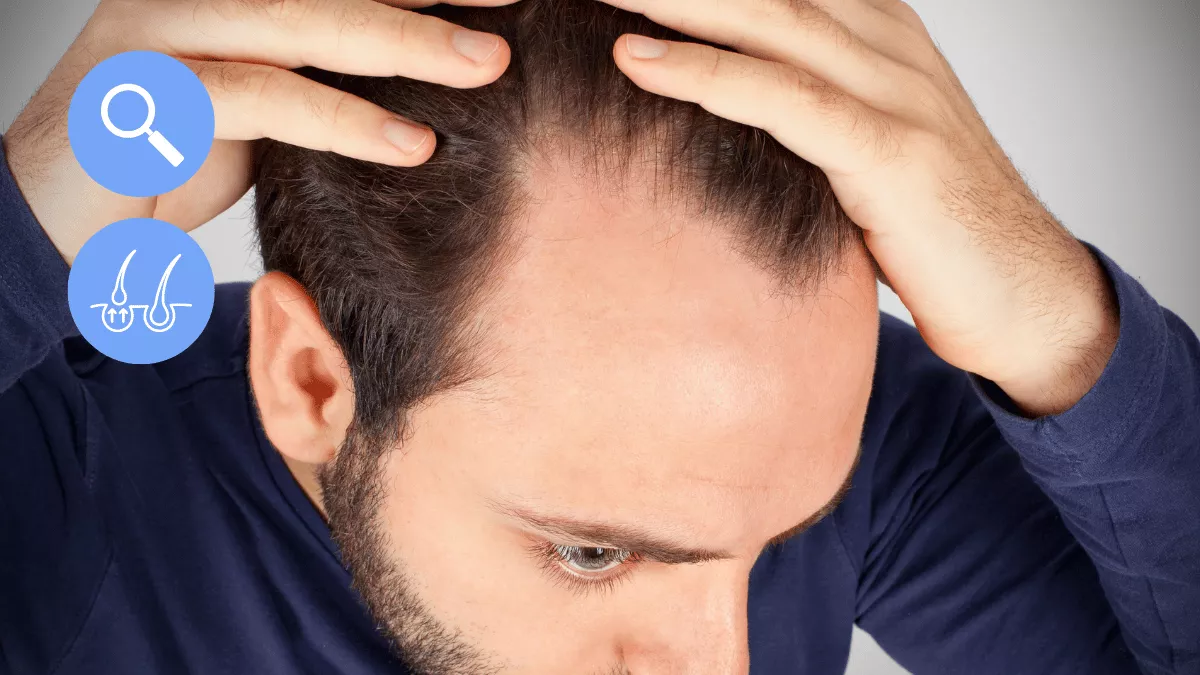The first sign of great-looking hair is your hairline at the temple points.
It’s where every person who meets you looks at first, where you see the most often in the mirror, and the part you comb the most.
Naturally, if you are experiencing hair loss, the earliest signs will appear at your temporal points.
👉 If you believe this early sign is at your door, fear not; we came to you with critical points for saving your hair before too late.
So, in today’s article, I will explain to you what is temple hair loss, why it occurs, and what our options are for preventing and even reversing it:
Table of Contents
Let’s start by understanding what it is:
What Is Temple Hair Loss?
Generally, male pattern baldness (or androgenetic alopecia) appears first in two fundamental points: The crown or the temples.
💡 When you’re in your very early age of balding, your hair starts falling from the front hairlines. We call this place the temple hair loss point.
As time goes on, without any natural or surgical methods to reverse this process, your first permanent hair loss happens at your temples.
However, you should note that MPB is not the sole reason for temple hair loss:
What causes temple hair loss?
The primary reason for hair loss in the temples is likely male pattern hair baldness.
Its process happens similarly to balding anywhere else; DHT damages your hair follicles by restricting their growth.
However, if you are suffering from temple hair loss only lately, there may be other factors triggering this process, such as:
➡️ Stress
➡️ Medication side effects
➡️ Vitamin deficiency
➡️ Addiction levels of alcohol consumption
➡️ Smoking
➡️ Hormonal changes
With this many potential candidates, your temple hair is quite fragile.
And since it is also the first part of your scalp that gets damaged by hair loss in any way, it is also the most crucial:
Why Is Temple Hair Important?

As the Norwood Scale indicates, temple hair loss is one of the first signs of male pattern baldness. But that is not all.
Your temple hair is part of your scalp that creates and shapes your initial hairline.
As your temple falls victim to balding, it continues eating your remaining hair follicles towards the back of your head.
⚠️ In other words, the longer you wait to treat temple hair loss, the more your hair gets a “pushed back” look (check III A).
And that brings us to the damaged subject: Your healthy-looking facial proportions.
Without your temple hair in place, your hairline starts losing balance to frame your face correctly.
Ultimately, your scalp appears more than your hair, damaging your facial aesthetics and overall look.
But we cannot allow that to happen.
🍀 Your hair is essential to your outlook, and you should invest in it accordingly. After all, you wear it every day.
So, starting from the bottom, here are your options for treating it:
How to grow temple hair back
💠 To see what we can do about your temple hair loss, we must first find out how much your balding has advanced.
As I have said, MPB hits your temple points first, so you must act fast if your hairline recurs.
If you are at this stage, where your balding has just started, you are lucky to look for non-surgical options.
For our patients in this stage, we suggest 3 options:
1️⃣ Finasteride for eliminating the production of the DHT hormone to prevent your hair loss,
2️⃣ Minoxidil to increase the blood flow in your scalp and stimulate hair regrowth,
3️⃣ And lastly, natural alternatives for reshaping your daily routine to a healthier lifestyle for your hair.
But if your balding has progressed enough to disrupt your hairline entirely, you may need to get a transplant:
Getting a Temple Hair Transplant
You can get a temple hair transplant, the most effective treatment if your balding has significantly advanced.
And their surgery process is the same as any other hair transplant process, especially if you prefer FUE.
However, one tricky part is recreating the hairline properly, as creating a too-straight line can make it look fake.
In this case, Dr. Utkan has a neat trick to create a natural-looking hairline and avoid a grass-head look:
Aside from its delicate process, the cost and the necessary number of grafts for a temple hair transplant surgery are similar to any other ordinary transplant.
In other words, it depends entirely on you, on how much your balding has advanced and how many grafts your head will need.
✅ As of 2023, for a hair transplant surgery in Turkey, the average price per Graft is $1.3, while the average price for 2000 Grafts is $2676.
Now that you know all about temple hair loss, our final note is: Are you entirely sure it is time to get a temple hair transplant?
Like any other transplant, you must also ensure that you are suitable for getting a hair transplant beforehand.
That’s where we come in:
Get a free consultation now 🩺

At UnitedCare, we begin your hair transplant process by offering you a free one-on-one consultation with our expert doctors to determine your suitability.
If so, our holistic approach provides advanced technologies and bio-enhancements to ensure you do not need another surgery.
Once you have decided on a method, we begin the treatment with the utmost attention.
But most importantly, we stay in contact with our patients even long after the surgery, ensuring that your transplant becomes permanent.
Affordable hair transplant costs, a holistic approach, and experienced dermatologists on-site are here to provide you with the right solution.
Ready to begin the journey? Click here to start the first step with a free consultation:
Bring your hairline back, healthier, and better-looking than ever.
Restore your natural look with a Dermatosurgeon:
Frequently Asked Questions (FAQs)
Is thinner hair at the temples normal?
Yes, it is normal. Your temple is the point where your initial hairline begins. So, naturally, it will have a thinner appearance as most of the hair grows towards the back. However, getting even thinner over time can signify the early stages of balding. If you worry about such a scenario, follow your hair’s progress in the mirror regularly.
Can you thicken your temple hair?
Yes, but only if your temple hair has been affected by balding. In its natural state, without any effects of hair loss, your temple hair will look slightly thinner than the rest, but that is normal. However, if your temple hair got thinner due to MPB, you can apply some natural or clinical methods to reverse this process. The most commonly used and advised ones are using medications such as Finasteride or Minoxidil. You can also make natural changes in your daily habits to boost thicker hair. And lastly, if your balding has advanced enough to make these options unusable, you may consider a transplant.
Can you have a hair transplant on your temples?
Yes, you can have a temple hair transplant like an ordinary one. And similarly, temple hair transplants are unique for every patient too. So, depending on what will be required to recreate your hairline correctly, the cost for your temple hair transplant and the necessary amounts of graft can vary. As of 2023, for a hair transplant surgery in Turkey, the average price per Graft is $1.3, while the average price for 2000 Grafts is $2676.


